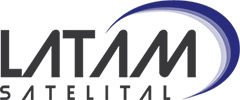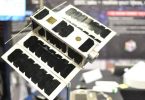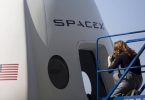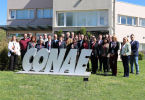Sim&Tec is an Argentine company specialized in computational modeling. Application of scientific knowledge in the space industry for the SARE, ARSAT-1 and ARSAT-2 missions and the Tronador rocket.
Español | English
Latam Satelital interviewed Dr. Eduardo Dvorkin, COO of Sim&Tec, a member of the ecosystem of institutions that contribute the national component of the satellite missions and launch vehicles that are designed and manufactured in Argentina.
What is Sim&Tec activity? How is your relationship with the Space Industry?
Sim&Tec is a company that focuses its activity on the subject of computational modeling. Computational modeling of the response of structures to thermo-mechanical, static and dynamic loads; computational modeling of fluid flow and computational modeling of heat transfer problems. Since the reality that must be modeled, usually incorporates the coupling of structural, fluid and thermal behavior, the development of coupled models has been transformed over the years into an important aspect of our activity.
Sim&Tec is a company formed 10 years ago by professionals who come from the fields of scientific research and technological research and consequently our objective is to apply scientific knowledge to the development of technological applications.
We have worked modeling industrial processes and modeling the behavior of products in the development phase or optimizing them for several industries, being the most relevant: the oil industry, the steel industry and the aerospace industry. In this last industry we have worked developing models for applications of INVAP S.E., CONAE – VENG S.A. and FAdeA S.A.
Computational modeling is a scientific discipline in which the methodologies that are used and the theoretical concepts that are handled are independent of the application that is being modeled, so that the experiences that we obtain from our jobs with different industries are additive and all strengthen the capabilities of our company to face new and different jobs, in particular in the framework of the aerospace industry.
In the background section on our website we publish some jobs developed by Sim&Tec and in particular developments for the aerospace industry.
How is Sim&Tec composed? What is the professional profile of the company?
Sim&Tec is composed by engineers and science graduates specialized in computational mechanics.
In the Company section on our website we list the names of the people that occupy the positions in our organization chart and we add the summarized CVs and the complete CVs of Sim&Tec partners that are those of us that having larger scientific and academic background, lead the daily execution of the different jobs.
In the Publications section we present some of the publications of our professionals in the scientific literature.
It is also important to note that in our quality system, certified by DNV-GL according to ISO 9001, formal continuous education is established as an essential requisite for our professionals. The different levels we have set to guide the development of professional careers at Sim&Tec are:
• Level N1 (Analyst): Student or Engineer or Science Graduate of recent graduation
• Level N2 (Junior Project Engineer): Engineer or Science Graduate.
• Level N3 (Senior Project Engineer): Engineer or Science Graduate.
• Level N4 (Area Manager): Engineer or Science Graduate.
The above levels were established using the following criteria:
• Level of formal education.
• Referential function in technical areas.
• Technical and administrative leadership of projects.
That is, we look for a very high professional profile of the employees who work in our company and we are determined to continue investing resources so that our employees can increase their levels of scientific and technological education.
What were the most outstanding jobs for the industry?
The most relevant problems we faced were the simulation of the dynamic tests of the satellites ARSAT-1 and ARSAT-2; the simulation of the thermal stresses / deformations in ARSAT- 1 and their influence on the satellite’s pointing; the structural modeling for the development of the SARE satellite; the modeling of sloshing problems in the liquid fuel tanks of the satellite launchers being developed by Veng; the design and structural modeling of the Composite Overwrapped Pressure Vessels (COPV) that are being manufactured by an Argentine SME (Small and Medium sized Enterprises) for use in satellite launchers.
Why is computational modeling important in space activity?
Our experience in various industries shows that the development of technologies using computer models to simulate operating conditions or extreme situations is effective and efficient. Some examples,
- The threaded connections for oil pipes of equal mechanical strength to that of the connected pipes and with sealability to gas leaking were developed by our engineers, for the company Tenaris, using intensive computational modeling, since the classic approach which is to design, test, correct the design, re-test, etc. requires a lot of resources and a lot of development time, while resorting to computational modeling has reduced development times and costs. Once the designs were consolidated, laboratory tests were performed to validate the results of the models, but only on the designs finally established.
- The hydraulic fracture simulator, currently under development for YTEC (YPF Technology), will enable the oil company to test various fracture schemes without having to face the costs and time of the intensive use of field tests. Of course the results of the models are to be validated comparing them with experimental determinations.
Specifically, in the aerospace industry.
- Testing of structural and flight models of satellites, using computer models, before performing the experimental measurements, allows the laboratory tests to be carried out with the assurance that the results will be successful. In addition, in a test the structure behavior is acquired only at the points where instrumentation is placed. In contrast, the computational models enable to determine the behavior of the structure at any point; hence, the models are very useful to determine the relevant points where to place the instrumentation. There are areas that during the dynamic tests of the satellites cannot be instrumented so their design must be based on the results of the computational models. Without the computational models today it would be impractical to launch a satellite, both for the economic cost that would entail successive experimental tests that without previous simulations would be “blind” tests, as well as for the additional time that this would demand.
- The design of the aforementioned COPV.
Any examples of problems that were detected in the simulation and allowed to correct designs?
In fact, detecting a problem in a product or process design during the simulation in order to correct it is part of our daily routine; but, I will mention some cases that seemed, at the time, more relevant:
• In ARSAT-1 thermal vacuum test, it was sought that certain equipment reached predetermined test temperatures; the thermal regime that was established for that purpose meant that in certain sections of the satellite structure the design temperature would be exceeded. The structural model detected that the stresses in some bolts exceeded, during this test, the acceptable tension stress for the bolt material, so it was indicated that during the test in certain bolts, lower tightening torques were used, so that these connections could slip, reducing the load on the overloaded bolts.
- During the development of threaded joints for oil tubes, comparing the results of the computational models with the laboratory measurements (strain gauges) deviations were detected, which we attributed to the high pressure that reached the grease retained in the connection. The problem was solved and the solution was patented, being part of the team of inventors our partner Dr. Rita Toscano.There are trends currently in the industry that seek to reduce costs on satellites using shelf components (not specially designed for space). What can Sim&Tec capabilities bring in this trends?
We have worked on these issues for the SARE satellite under development at INVAP, in particular on the modeling of a Ball Grid Array chip, in which with finite element models we have studied the life of this chip due to the creep of the material during the space mission.







